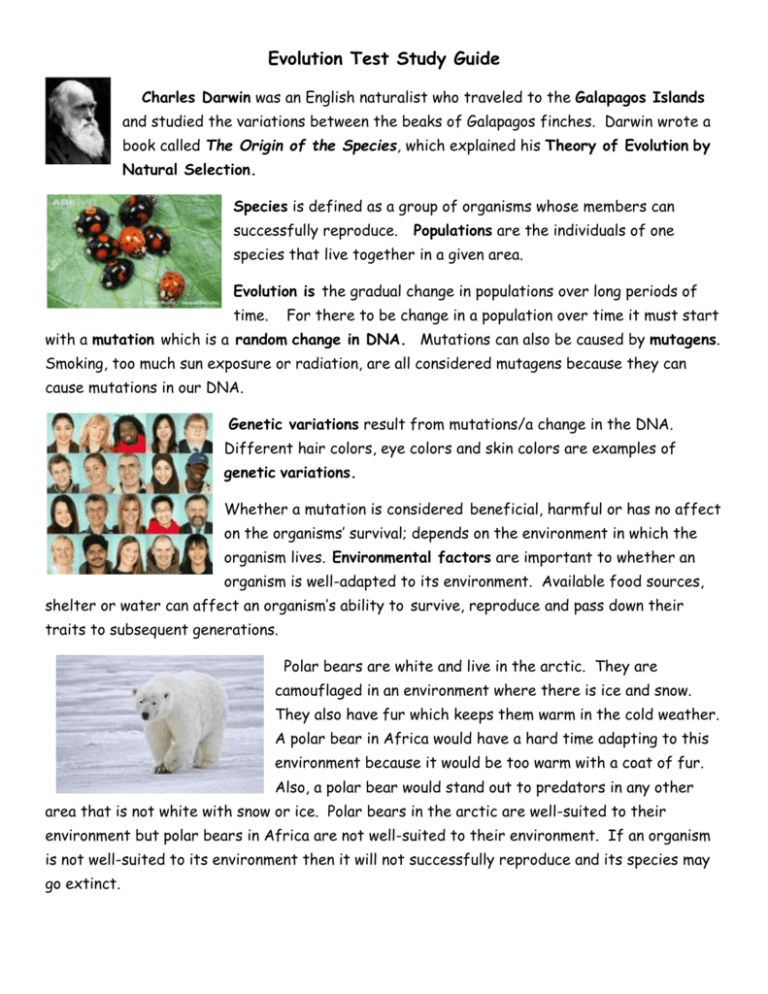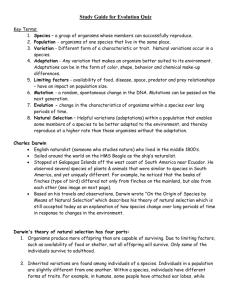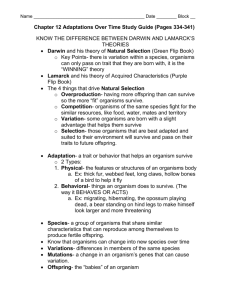Evolution Test Study Guide
advertisement

Evolution Test Study Guide Charles Darwin was an English naturalist who traveled to the Galapagos Islands and studied the variations between the beaks of Galapagos finches. Darwin wrote a book called The Origin of the Species, which explained his Theory of Evolution by Natural Selection. Species is defined as a group of organisms whose members can successfully reproduce. Populations are the individuals of one species that live together in a given area. Evolution is the gradual change in populations over long periods of time. For there to be change in a population over time it must start with a mutation which is a random change in DNA. Mutations can also be caused by mutagens. Smoking, too much sun exposure or radiation, are all considered mutagens because they can cause mutations in our DNA. Genetic variations result from mutations/a change in the DNA. Different hair colors, eye colors and skin colors are examples of genetic variations. Whether a mutation is considered beneficial, harmful or has no affect on the organisms’ survival; depends on the environment in which the organism lives. Environmental factors are important to whether an organism is well-adapted to its environment. Available food sources, shelter or water can affect an organism’s ability to survive, reproduce and pass down their traits to subsequent generations. Polar bears are white and live in the arctic. They are camouflaged in an environment where there is ice and snow. They also have fur which keeps them warm in the cold weather. A polar bear in Africa would have a hard time adapting to this environment because it would be too warm with a coat of fur. Also, a polar bear would stand out to predators in any other area that is not white with snow or ice. Polar bears in the arctic are well-suited to their environment but polar bears in Africa are not well-suited to their environment. If an organism is not well-suited to its environment then it will not successfully reproduce and its species may go extinct. 4 Parts to Darwins Theory of Evolution by Natural Selection 1.Overproduction: each species produces more offspring than will survive. 2. Genetic Variation: Individuals in a population are slightly different from one another. These variations increase, decrease or have no effect on an organisms chance of survival. 3. Struggle to survive: a natural environment does not have enough food, water and other resources to support all organisms. Only some will survive to adulthood. 4. Successful Reproduction: is the key to natural selection. Individuals that are well-suited to their environment will survive and reproduce, passing down those successful traits to their offspring. The organisms that are not well-suited or welladapted are more likely to die early and not have offspring. 2 Types of Adaptations Structural adaptation: parts of an organisms body that helps them to survive in their environment ex: mimicry: frog with bright coloring that looks like a poisonous frog but it is not poisonous. Camouflage: the ability to blend in with the surroundings and not end up being prey. Structures like wings on a bird that help it to fly south for the winter. Behavioral Adaptation: the manner in which an animal acts to help it to survive in its environment ex: a possum playing dead to avoid being eaten by a predator. EVIDENCE OF EVOLUTION 1. Fossils: are imprints of organisms that were once living. Fossils found provide evidence that organisms have evolved from less advanced to more advanced organisms over time. 2. Vestigial Structures: Structures that were once useful but now serve no purpose. Whales having hind limb bones suggest that whales have evolved from a land dwelling mammal. 3. Microevolution: Genetic variation within a population suggests that organisms are changing over time. 4. Similar DNA: all organisms have DNA suggests we all came from a common ancestor. 5. Homologous Structures: Different organisms sometimes have similar structures, such as bones, that may or may not be used in the same way. This could suggest they came from a common ancestor. 6. Radiometric Dating: The process of determining the age of an object or event in years, usually by measuring the amount of unstable atoms in the sample (ex. Carbon-dating) Vocabulary Species – a group of organisms whose members can successfully reproduce. Population - organisms of one species that live in the same place. Variation - Different forms of a characteristic or trait. Natural variations occur in a species. (For example, humans have different eye, hair, and skin color.) Adaptation - Any variation that makes an organism better suited to its environment. Adaptations can be in the form of color, shape, behavior and chemical make-up differences. Limiting factors - availability of food, disease, space, predator and prey relationships – have an impact on population size. Mutation - a random, spontaneous change in the DNA. Mutations can be passed on the next generation. Evolution - change in the characteristics of organisms within a species over long periods of time. Natural Selection – Helpful variations (adaptations) within a population that enables some members of a species to be better adapted to the environment, and thereby reproduce at a higher rate than those organisms without the adaptation.








